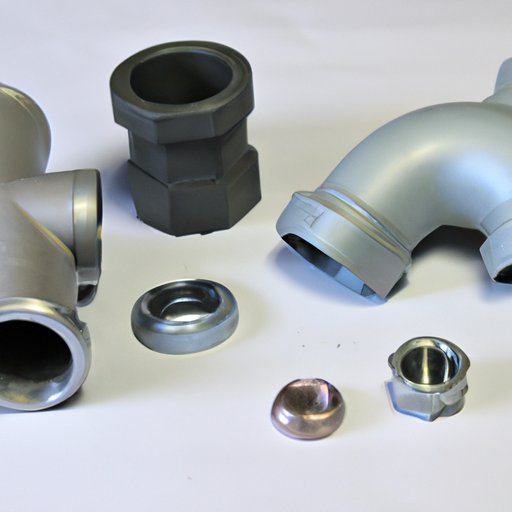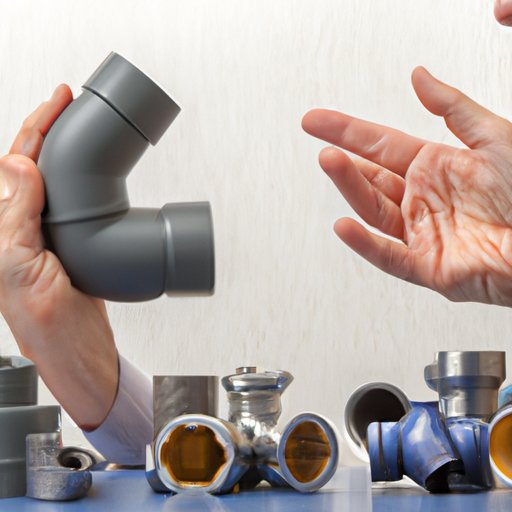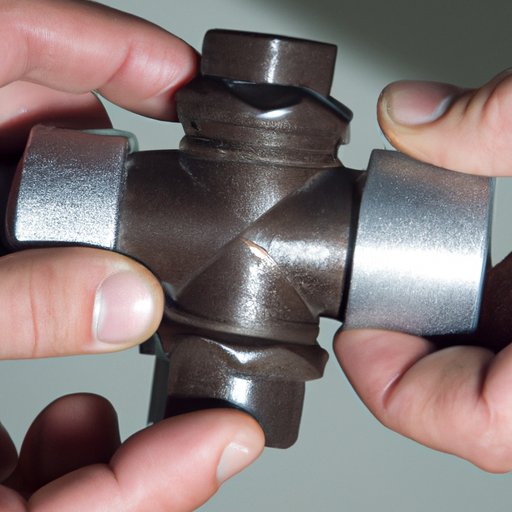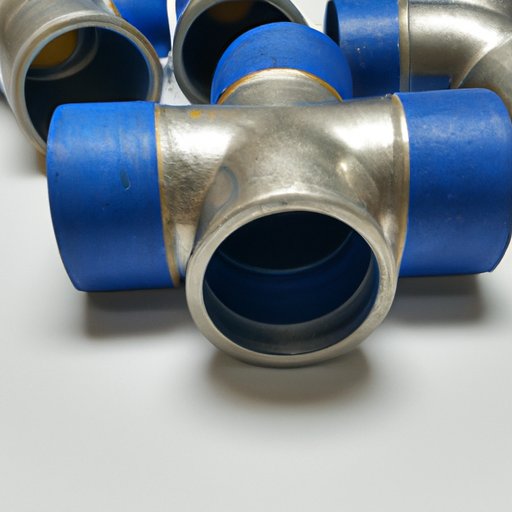Introduction: What is Pipe Fitting and Why is it Important?
Pipe fitting is the process of connecting two pieces of piping together in order to form a single system. It involves cutting, threading, and joining pipes, as well as installing valves and other components. Pipe fitting is an essential part of many plumbing and construction projects, as it allows for water, gas, or other liquids to be transported safely and efficiently.
The importance of pipe fitting cannot be overstated. According to the American Society of Plumbing Engineers, “properly installed and maintained piping systems are essential to our quality of life and the protection of our environment.” Without proper pipe fitting, plumbing systems would not function properly and could cause serious safety risks. In addition, poorly fitted pipes can lead to costly repairs and replacements down the line.
A Comprehensive Guide to Pipe Fitting: Exploring Different Types and Uses
When it comes to pipe fitting, there are many different types and uses to consider. The type of pipe fitting you choose will depend on the specific application, as each type has its own advantages and disadvantages. Here is a brief overview of the most common types of pipe fittings and their uses:
Different Types of Pipe Fittings
Elbow fittings: Elbows are used to change the direction of piping. They come in various angles, such as 45°, 90°, and 180°.
Tee fittings: Tees are used to connect three pieces of pipe together. They come in straight, reducing, and Y-shaped configurations.
Coupling fittings: Couplings are used to join two pieces of pipe together. They come in slip, compression, and threaded varieties.
Union fittings: Unions are used to quickly disconnect two pieces of pipe without having to cut them. They come in male, female, and socket types.
Flange fittings: Flanges are used to connect two pieces of pipe with a gasket in between. They come in flat face, raised face, and tongue and groove varieties.
Adapter fittings: Adapters are used to connect two different types of pipe together. They come in male and female varieties.
Uses of Different Types of Pipe Fittings
Elbows are commonly used in plumbing and HVAC applications to connect two pipes at an angle. Tees are commonly used in irrigation systems to connect three pipes together. Couplings are commonly used to join two pieces of pipe together. Unions are commonly used to quickly disconnect two pieces of pipe without having to cut them. Flanges are commonly used in oil and gas applications to connect two pieces of pipe with a gasket in between. Adapters are commonly used to connect two different types of pipe together.

The Basics of Pipe Fitting: An Overview of Installation and Maintenance
Once you have chosen the right pipe fitting for your project, the next step is to install it. The installation process will vary depending on the type of pipe fitting being used, but there are some basic steps that should be followed for all installations:
Installation Process
1. Measure and mark the pipe for cutting.
2. Cut the pipe using the appropriate tools.
3. Check the fit of the pipe and fitting before applying any sealant.
4. Apply the sealant to the threads of the pipe and fitting.
5. Hand-tighten the pipe and fitting together.
6. Use a wrench to tighten the connection further.
7. Test the connection for leaks.
Maintenance Tips and Techniques
In order to ensure the longevity and effectiveness of your pipe fitting, it is important to perform regular maintenance. This includes checking for any signs of corrosion or leakage, and replacing any worn or damaged parts. Additionally, it is important to make sure the connections are tight and secure. If you notice any issues, it is important to address them as soon as possible to avoid any further damage.
Pipe Fitting: The Pros, Cons and Cost Considerations
Pipe fitting offers many advantages, including the ability to customize your piping system, save time and money, and reduce the chance of leaks. However, there are also some disadvantages, such as the potential for costly mistakes or the need for special tools and materials. Additionally, cost is an important factor to consider when choosing a pipe fitting.
Advantages of Pipe Fitting
One of the major benefits of pipe fitting is the ability to customize your piping system. With the right fittings, you can create a system that fits your exact needs and specifications. Additionally, pipe fitting can save you time and money by avoiding costly mistakes, such as cutting and threading pipes incorrectly. Pipe fitting can also reduce the chance of leaks, as the joints are sealed more effectively than with traditional methods.
Disadvantages of Pipe Fitting
Though pipe fitting offers many benefits, there are also some drawbacks to consider. For example, it requires special tools and materials, which can be expensive. Additionally, if not done correctly, pipe fitting can result in costly mistakes or even dangerous leaks.
Cost Considerations
When considering pipe fitting, cost is an important factor to consider. Depending on the type of fitting you need, the cost can range from a few dollars to several hundred dollars. Additionally, the cost of installation will depend on the complexity of the job and the number of fittings needed.

How to Choose the Right Pipe Fitting for Your Project
Choosing the right pipe fitting for your project is essential to ensure a successful installation. There are several factors to consider when selecting a pipe fitting, such as size, material, pressure rating, and compatibility. Additionally, it is important to make sure the fittings you choose are compatible with the pipes you are using.
Factors to Consider When Choosing a Pipe Fitting
Size: Make sure the fitting is the same size as the pipes you are using.
Material: Choose a fitting that is made from a material compatible with the pipes you are using.
Pressure Rating: Make sure the fitting is rated for the pressure of the system.
Compatibility: Ensure the fitting is compatible with the pipes you are using.
Common Mistakes to Avoid
It is important to avoid common mistakes when choosing a pipe fitting. These include selecting the wrong size fitting, using incompatible materials, and failing to check the pressure rating. Additionally, it is important to make sure the fitting is compatible with the pipes you are using.

Pipe Fitting: Tips and Techniques for a Successful Installation
Once you have chosen the right pipe fitting for your project, the next step is to install it. Installing a pipe fitting requires careful planning and a number of tools, such as wrenches, saws, and sealants. Here is a step-by-step guide to help ensure a successful installation:
Tools Needed for Installation
Wrenches: Wrenches are used to tighten the connections.
Saws: Saws are used to cut the pipes.
Sealants: Sealants are used to prevent leaks.
Step-by-Step Installation Process
1. Measure and mark the pipe for cutting.
2. Cut the pipe using the appropriate saw.
3. Check the fit of the pipe and fitting before applying any sealant.
4. Apply the sealant to the threads of the pipe and fitting.
5. Hand-tighten the pipe and fitting together.
6. Use a wrench to tighten the connection further.
7. Test the connection for leaks.
Conclusion
When it comes to pipe fitting, there are many different types and uses to consider. It is important to choose the right fitting for your project, as well as the right tools and materials. Additionally, it is essential to follow the proper installation procedures to ensure a successful installation. By following these tips and techniques, you can ensure a safe and efficient pipe fitting project.
Summary of Key Points
• Pipe fitting is the process of connecting two pieces of piping together in order to form a single system.
• There are many different types and uses of pipe fittings, such as elbows, tees, couplings, unions, flanges, and adapters.
• The installation process for pipe fitting involves measuring, cutting, sealing, and testing for leaks.
• Regular maintenance is essential to ensure the longevity and effectiveness of your pipe fitting.
• When choosing a pipe fitting, it is important to consider size, material, pressure rating, and compatibility.
• Installing a pipe fitting requires careful planning and the use of certain tools, such as wrenches, saws, and sealants.
Final Thoughts
Pipe fitting is an essential part of many plumbing and construction projects, as it allows for water, gas, or other liquids to be transported safely and efficiently. With the right fittings, you can create a system that fits your exact needs and specifications. Additionally, it is important to follow the proper installation procedures to ensure a successful installation. By following these tips and techniques, you can ensure a safe and efficient pipe fitting project.
(Note: Is this article not meeting your expectations? Do you have knowledge or insights to share? Unlock new opportunities and expand your reach by joining our authors team. Click Registration to join us and share your expertise with our readers.)
